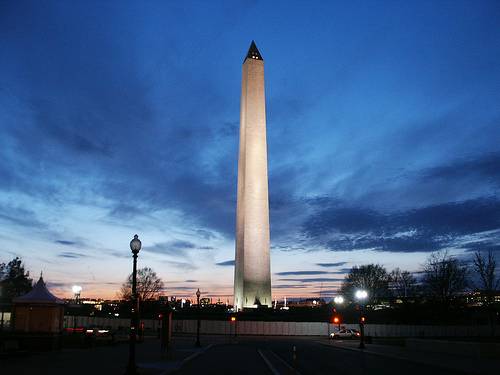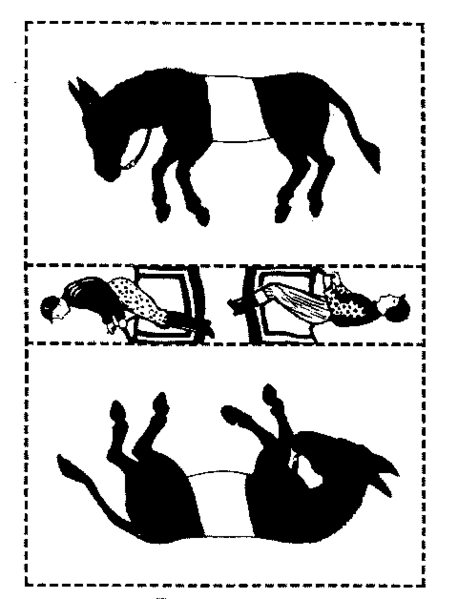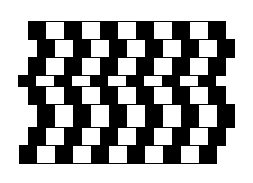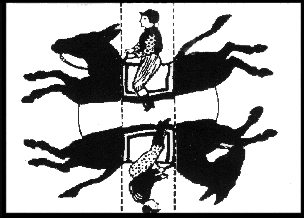How quickly can you find out what is unusual about this paragraph? It looks so ordinary that you would think that nothing was wrong with it at all and, in fact, nothing is. But it is unusual. Why? If you study it and think about it you may find out, but I am not going to assist you in any way. You must do it without coaching. No doubt, if you work at it for long, it will dawn on you. Who knows? Go to work and try your skill. Par is about half an hour.
Straight and Narrow
“The One-Man Vaudeville Show”
“I will now give an imitation of three Hawaiians. This is one (whistles), this is another (plays ukulele), and this is the third (marks time with his foot). I could imitate four Hawaiians just as easily, but I will tell you the reason why I don’t do it. You see, I bought a horse for $50, and it turned out to be a running horse. I was offered $15,000 for him, and I took it. I built a house with the $15,000, and when it was finished a neighbor offered me $100,000 for it. He said my house stood right where he wanted to dig a well. So I took the $100,000 to accommodate him. I invested the $100,000 in peanuts, and that year there was a peanut famine, so I sold the peanuts for $350,000. Now, why should a man with $350,000 bother to imitate four Hawaiians?”
— Joe Cook, vaudeville performer
Limerick
A decrepit old gas man named Peter,
While hunting around for the meter,
Touched a leak with his light.
He arose out of sight,
And, as anyone can see by reading this, he also destroyed the meter.
— Anonymous
Stature in Washington

At the time of its construction, the Washington Monument was the tallest building in the world.
Palindromes
Real-life palindromes:
- MALAYALAM is a language of southern India.
- EKALAKA LAKE exists in southeastern Montana.
- DR. (Michael) AWKWARD is Longstreet Professor of English and Afro-American Literature at Emory University.
Well, Hey!
How to Cure Cancer. — Boil down the inner bark of red and white oak to the consistency of molasses; apply as a plaster, shifting it once a week; or, burn red-oak bark to ashes; sprinkle it on the sore till it is eaten out; then apply a plaster of tar; or, take garget berries and leaves of stramonium; simmer them together in equal parts of neatsfoot oil and the tops of hemlock; mix well together, and apply it to the parts affected; at the same time make a tea of winter-green (root and branch); put a handful into two quarts of water; add two ounces of sulphur and drink of this tea freely during the day.
— Barkham Burroughs’ Encyclopaedia of Astounding Facts and Useful Information, 1889
Self-Help
Benjamin Franklin’s “13 virtues,” which he devised for “the bold and arduous project of arriving at moral perfection”:
- TEMPERANCE. Eat not to dullness; drink not to elevation.
- SILENCE. Speak not but what may benefit others or yourself; avoid trifling conversation.
- ORDER. Let all your things have their places; let each part of your business have its time.
- RESOLUTION. Resolve to perform what you ought; perform without fail what you resolve.
- FRUGALITY. Make no expense but to do good to others or yourself; i.e., waste nothing.
- INDUSTRY. Lose no time; be always employ’d in something useful; cut off all unnecessary actions.
- SINCERITY. Use no hurtful deceit; think innocently and justly, and, if you speak, speak accordingly.
- JUSTICE. Wrong none by doing injuries, or omitting the benefits that are your duty.
- MODERATION. Avoid extreams; forbear resenting injuries so much as you think they deserve.
- CLEANLINESS. Tolerate no uncleanliness in body, cloaths, or habitation.
- TRANQUILLITY. Be not disturbed at trifles, or at accidents common or unavoidable.
- CHASTITY. Rarely use venery but for health or offspring, never to dulness, weakness, or the injury of your own or another’s peace or reputation.
- HUMILITY. Imitate Jesus and Socrates.
“It may be well my posterity should be informed that to this little artifice, with the blessing of God, their ancestor ow’d the constant felicity of his life, down to his 79th year, in which this is written.”
Trick Mules Puzzle
Sam Loyd was only 17 when his “Trick Mules Puzzle” swept the country in 1858. He finally sold it to P.T. Barnum for $10,000.
Print this page and cut out the three pieces along the dashed lines. Now arrange them so that it looks like each jockey is riding a mule. You may overlap the pieces, but you mustn’t fold them.
It’s harder than it looks.

Unquote
“helen write anna george will give helen apple simpson will shoot bird jack will give helen stick of candy doctor will give mildred medicine mother will make mildred new dress”
— A letter from Helen Keller to a cousin, three and a half months after Annie Sullivan came to teach her


